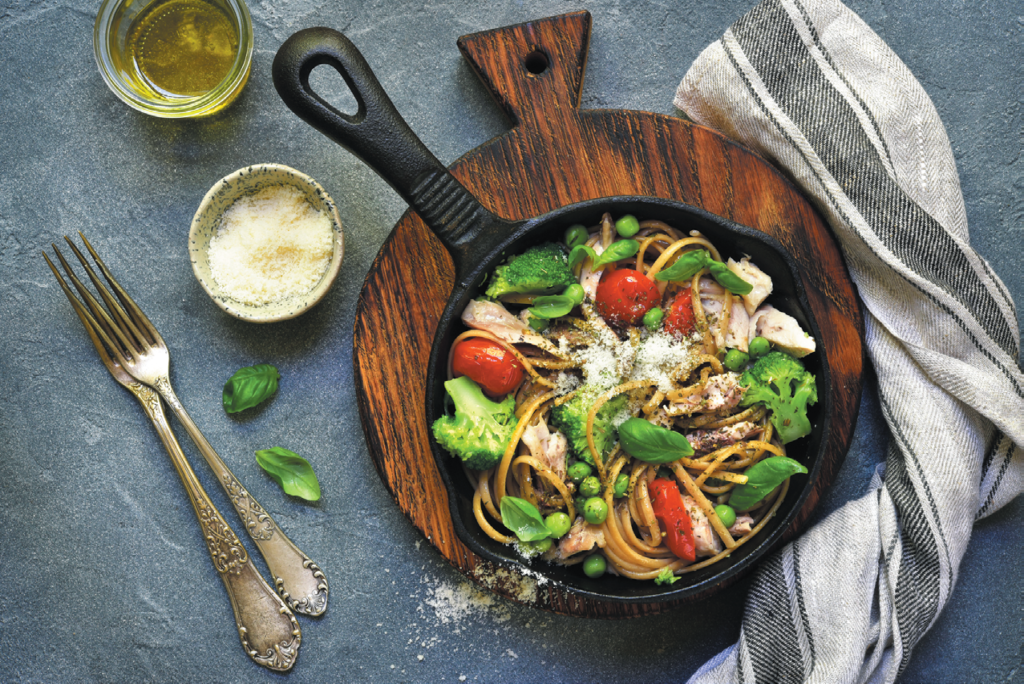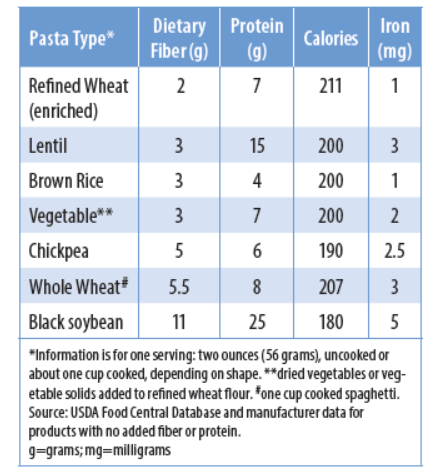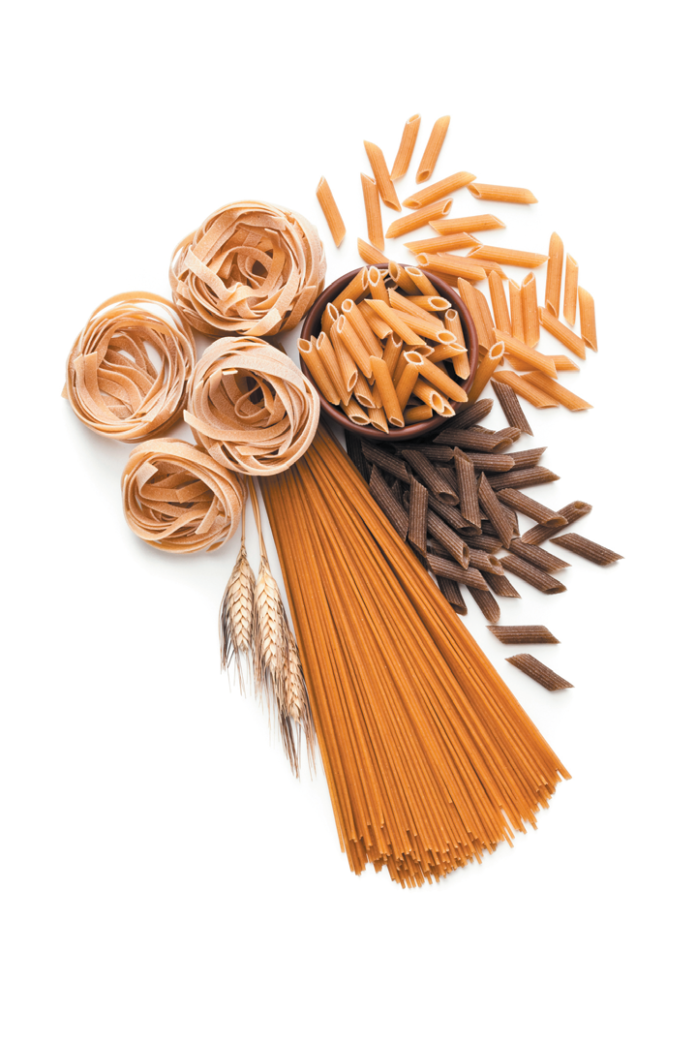The marketplace has seen an increase in pasta products made from seemingly more nutritious ingredients, such as whole wheat, legumes, or brown rice. But are these products really better (or even good) for health?
Pasta Basics: Traditionally, pasta is made from milled durum wheat. Processing of the wheat to make refined flour removes the bran and germ, leaving only the starchy endosperm. This process strips away most of the fiber as well as vitamins like niacin. In the U.S., the major vitamins found in whole wheat (niacin, riboflavin, and thiamine) as well as folate and the mineral iron must be added to all refined white flours.
When wheat-based flour is kneaded with water, a gluten protein matrix forms around the starch particles and the dough becomes strong and stretchy. “This matrix may lead to slower digestion of the starch particles and slower release of glucose, and it may help you to feel fuller,” says Nicola M. McKeown, PhD, associate professor at the Friedman School of Nutrition Science and Policy.
Try these tips for picking pastas:
- Choose whole wheat. Whole wheat has more than double the dietary fiber of traditional white pasta.
- Portion your servings. A single serving of any pasta is two ounces (one-half cup) dry, or one cup cooked, even when pasta is part of the main dish.
- Fill out the meal. Enjoy pasta with a serving of vegetables and/or protein with low-sodium tomato sauce, or some olive oil and a squeeze of lemon juice.
- Check the labels. Look for whole grains or legumes (lentils or beans) as the first (or only) item on the ingredient list.
- Go for natural fiber. Added fibers (like inulin, xanthan gum, and pectin) may not have the same health effects as natural fibers.
- Consider alternatives. Legume-based pastas can be high fiber, high protein alternatives to wheat-based pastas, and can add variety in terms of taste and texture.
- Do some math: Divide the grams of Total Carbohydrates on the Nutrition Facts label by the grams of Dietary Fiber. Processed foods with results less than 10 tend to be more nutritious overall.
Whole Wheat Benefits: The flour used to make whole wheat pasta retains most of the bran and germ. The result is a more textured and hearty pasta that delivers more than twice the fiber and iron of enriched refined pasta (see chart on page 7). “The substantial amount of dietary fiber in whole wheat pasta is, I would argue, the biggest benefit of choosing whole wheat over refined when possible,” says McKeown. “Dietary fiber can help in maintaining a healthy weight, lowering risk of diabetes and heart disease, and promoting gut health.” Fiber may be one of the reasons a feeding study found that whole grain pasta increased feelings of fullness and diminished hunger after meals compared to refined grain pasta, although this did not impact calorie intake at subsequent meals.
A number of manufacturers add fiber to refined-grain pastas. It is still unclear if added fibers have the same health benefits as the natural fiber in whole grains. If a box of pasta touts the products’ fiber content, look for whole grains listed near the top of the ingredient list to be sure you’re getting the most nutritional bang for your buck. If the taste or texture of whole wheat pasta does not appeal to you, try brands that mix whole wheat with refined flour.

Photography Images © Lilechka75 | Getty Images
Alternatives to Wheat: Non-wheat pastas are available in most markets. Many of these products are made from a mix of flours, including corn, white rice, and other grains or legumes (lentils and beans). Pastas made from lentil flour or specialty products like black soybean pastas may be considerably higher in protein than white or whole wheat pastas, and some non-wheat products (like those made from chickpeas and other beans) may be naturally higher in fiber. Others, like those made from corn and rice flours, are unlikely to be appreciably more nutrient-rich than pastas made with refined white flour—and could be less so if they are not enriched. Most non-wheat products lack the gluten-protein matrix found in wheat-based products, so (while this may makesthem acceptable choices for people who must follow a gluten-free diet) their impact on blood sugar and satiety are not known and may not be equivalent to wheat pastas. So-called “vegetable” pastas are typically refined-wheat products colored with dried vegetables or vegetables solids like spinach or tomato. They may or may not offer a slight nutrient boost over traditional pastas. Alternative pasta products may be more costly than refined-grain pastas, so consumers must decide if any relatively minor nutritional differences are worth the price.

Serving Counts: One serving of pasta is two ounces (about a half-cup) dry, or about one cup cooked, depending on the shape. If pasta is the main dish, most people will typically serve themselves double or even triple this amount. Tomato sauce is a heathy option, but pasta is often served with meat sauces, butter, or creamy alfredo, which all add saturated-fat, may be high in sodium, and can double or triple the calories. Try topping pasta with lightly steamed vegetables and healthy proteins (like shrimp, sliced chicken, or beans) and tossing with a simple (preferably low-sodium) red sauce or olive oil and lemon juice to make that one-cup serving of pasta into a satisfying, complete meal. To round out the meal, serve pasta along with a crunchy, colorful salad.
The Bottom Line: Whole wheat pasta—with its natural fiber, vitamins, and minerals—is a good pasta choice. While the health effects of non-wheat pastas are largely unstudied, these options can add interesting tastes and textures to dishes, and some are naturally higher in fiber or protein than wheat products. Whatever you choose, keep servings reasonable (about one cup cooked for a main course) and eat pastas with healthy proteins, plenty of veggies, and sauces that don’t pile on the sodium or saturated fat.

























Is Buckwheat flour a good alternative? Soba noodles contain buckwheat which is not actually wheat.
From what I’ve seen, many “soba noodles” are a mixture of wheat and buckwheat flours (often more of the former than the latter), not 100% buckwheat flour. However, 100% buckwheat noodles are out there, so the ingredients need to be checked if you want only buckwheat in your noodles.
The 100% buckwheat noodles I eat (king soba) have a total carb/fiber ratio of 6.5 and a total protein content of 7 grams/serving. Since buckwheat is a complete protein, it seems like an excellent choice from a nutritional standpoint.
I recently began a search for 100% buckwheat noodles and found that most of the brands indicate their first ingredient to be wheat flour, not further defined, then buckwheat flour. One brand, EDEN ORGANIC 100%
Buckwheat Soba, made in Japan and imported by Eden Foods, provides everything I’ve been seeking in order to fulfill my enjoyment of pasta and feel good about flavor and nutrition. It’s all buckwheat according to the ingredient statement. Strand diameter is about “angel hair” size and the length is about 8 inches, making cooking time short ( 6 minutes +/-. ) and twirling an acceptable bite onto a fork easy. The length, shorter than the traditional spaghetti, makes many easily served combinations containing varied ingredients like mixed vegetables, salmon, shrimp, sun dried tomatoes and herbs in olive oil, many more.
I checked my Whole wheat Italian pasta and the only ingredient is wheat with the factor you mentioned being 8. The first time I ate it, my wife served a smaller portion for both of us and though I thought it would not be enough, it was a lot more filling than refined wheat pasta, She stir fries about 8 different vegetables and adds them to her pasta sauce. Molto bene! Graci.
Any word on edamame spaghetti? I cook all my pasta in the same pot as I am using to boil vegetables, hoping that some of the lost vitamins from cooking go in to the pasta.
Susanne has the right idea. Always cook rice or pasta in the liquid that is in canned veggies or water you cook them in. Most of the nutrients are in the liquids. Gary
And thank you for the tip on black soybean spaghetti which I saw at Aldis .
I tried lentil spaghetti pasta. It was awful…ropey.
On to whole wheat hopefully as angel hair.
Thanks for the ingredient info.
Does anyone know of studies comparing imported Italian pastas to American brands?
The imported dry pastas have a more coarse texture, & seem like they are less refined carbohydrate.
Bonza chickpea pasta has from 12-14 grams of protein, not the 6 grams of protein listed above. Other brands of chickpea pasta (I think it is most like refined pasta in texture) has similar amounts of protein. Please double check your data and update if possible. I hate for people to not have correct information.
Maryanne,’
Most folks in the regions we’ve been in Italy eat the pasta you’re asking about-Italian, often steel cut—semolina pasta,. That’s all i buy & does taste coarser (in a good way:), & Italians are by & large not as heavy as Americans.
So—besides whole wheat pasta—pasta made in Italy for us too—with tomato sauce, veggies (not boiled where much of nutrients disappear into water), shrimp,, clams, etc.
I use Farrow pasta from a local Italian grocery. Ratio is 5 or 6. I always add a lot of mushrooms to the sauce and steam broccoli, cauliflower and carrots to mix in with the pasta and sauce.